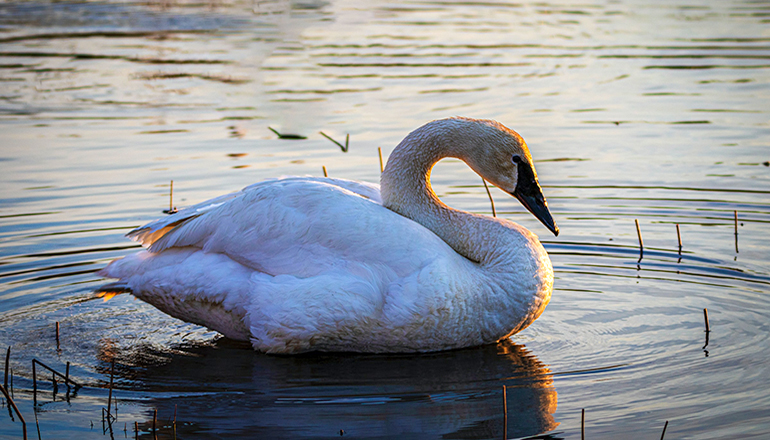They have voices like oboes, feathers like snow, and necks as graceful as a ballet dancer. Trumpeter swans are a bird distinct among the waterfowl that glide into western Missouri on the north winter winds, lingering until ice drives them southward. Watching them vies with spotting eagles and flocks of snow geese as a fun winter wildlife viewing activity, suggests the Missouri Department of Conservation.
Once almost extirpated from the Lower 48 states by the 1930s, conservation efforts have restored a breeding population of several thousand trumpeters in the upper Midwest. The swans are increasing in numbers as migrating winter visitors to Missouri, said Andy Raedeke, MDC scientist.
“We’ve seen a dramatic increase over the past decade,” Raedeke said. “Their population is growing, and they are establishing more of a migration tradition.”
A current hotspot for watching swans is the Loess Bluffs National Wildlife Refuge in Holt County north of St. Joseph. The U.S. Fish and Wildlife staff counted 2,584 trumpeter swans and 8 tundra swans at the wetlands on Dec. 5. The swans can be seen on the refuge driving tour. The Swan Lake National Wildlife Refuge in Chariton County reported 256 swans on the same day.
Managed wetlands are favored resting and feeding places for trumpeters. MDC’s Fountain Grove Conservation Area had 200 swans on Dec. 5. On Nov. 28, MDC staff counted three trumpeters at the Bob Brown Conservation Area and 8 swans at the Nodaway Valley Conservation Area. Swans also regularly visit other lakes, including small community lakes close to or within urban areas, including city parks. Trumpeter swans often return to the same lakes each winter if the water remains unfrozen.
Family groups are often seen together. The adults are mostly white except for neck and breast feathers stained from feeding or minerals in the water. Their black bills and feet stand out against the white feathers. Cygnets, the young of the year, are with their parents and are smaller and more grayish in color. Their trumpet name comes from their low-note-sounding calls that can carry long distances. A flock of trumpeters is noisy.
Trumpeters can have wingspans of 8 to 10 feet. When they arch their backs and long necks and stretch their wings upward, they are the epitome of grace and beauty. Yet they turn comical when they plunge their necks underwater to forage for vegetation or tubers, leaving only a back or bottom visible on the surface.
Most trumpeters visiting Missouri in winter have nested or were fledged in Minnesota, Iowa, or Wisconsin, Raedeke said. They once nested annually in north Missouri, and biologists say they perhaps will again someday. A few trumpeters have nested in the state’s northern counties in past decades.
Some trumpeters have identification collars so biologists can track population trends. Anyone spotting a collar and can record the number is asked to report it to an MDC office or conservation agent. Sightings can also be reported to the Trumpeter Swan Society.
Trumpeter swans are among Missouri’s most watchable winter wildlife and are no longer a surprise.
“I sometimes see them on ponds when I’m driving,” said Nate Mechlin, an MDC private lands conservationist based in Daviess County.
For more information about trumpeter swans in Missouri, visit this link on the Missouri Department of Conservation website.
(Photo by Camerauthor Photos on Unsplash)


